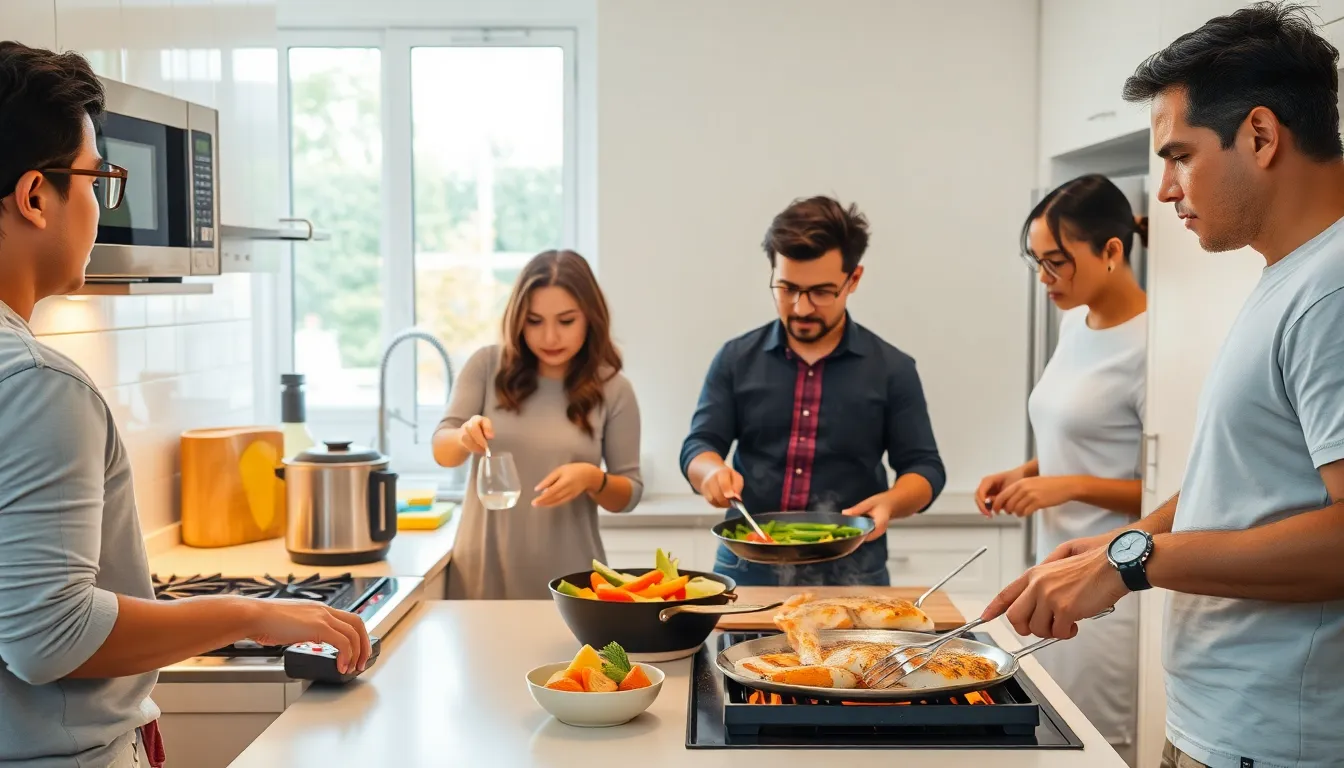In today’s fast-paced world, time is often a luxury many can’t afford, especially when it comes to cooking. Fast cooking methods have emerged as a game-changer, allowing people to whip up delicious meals without spending hours in the kitchen. Whether it’s a busy weeknight or a last-minute gathering, these techniques offer a solution that balances speed and flavor.
From pressure cooking to stir-frying, these methods not only save time but also preserve the nutrients and taste of ingredients. As home cooks seek efficiency without sacrificing quality, exploring these fast cooking methods can elevate any culinary experience. Embracing these techniques can transform the way meals are prepared, making cooking enjoyable and accessible for everyone.
Table of Contents
ToggleOverview of Fast Cooking Methods
Fast cooking methods allow individuals to prepare meals quickly and efficiently. These techniques cater to the demands of modern life while maintaining flavor and nutrition.
Pressure Cooking
Pressure cooking involves sealing food in a pot, trapping steam, and cooking at high temperatures. This method reduces cooking times by up to 70%. Dishes like stews, grains, and vegetables become tender in minutes, making it a preferred choice for busy cooks.
Stir-Frying
Stir-frying is a technique that cooks food quickly over high heat while continuously stirring. This method retains the nutrients and colors of vegetables. Typically, stir-frying involves cooking proteins, such as chicken or beef, with a mix of vegetables in less than 15 minutes.
Microwaving
Microwaving is an efficient cooking technique that uses electromagnetic waves to heat food rapidly. It’s suitable for reheating leftovers, steaming vegetables, or even preparing quick meals like omelets. Microwaved meals can be ready in just a few minutes.
Grilling
Grilling cooks food over direct heat, enhancing flavor while reducing cooking times. This method is ideal for meats, fish, and vegetables. Grilled meals typically take less than 20 minutes, offering a healthy and quick option for outdoor gatherings.
Broiling
Broiling is similar to grilling, but heat comes from above. It cooks food quickly while browning the surface. Broiled fish or chicken takes around 10-15 minutes, making it a time-efficient choice for flavorful meals.
Sous Vide
Sous vide combines precise temperature control with vacuum-sealed cooking. Foods cooked sous vide retain moisture and flavor while achieving perfect doneness. This method may require more time, but it provides consistent results and convenience without constant monitoring.
Utilizing these fast cooking methods enables home cooks to create delicious, nutritious meals swiftly, enhancing the overall cooking experience and accessibility.
Types of Fast Cooking Methods

Fast cooking methods simplify meal preparation, allowing quick and nutritious dishes. Here are several efficient cooking techniques that enhance culinary experiences.
Microwave Cooking
Microwave cooking uses electromagnetic radiation to heat food rapidly, cooking or reheating meals in minutes. It excels at fast preparation for leftovers, steaming vegetables, or instant meals. Cooking times vary according to food type, averaging 1-10 minutes for most dishes. Microwaves retain flavor and nutrition effectively, making them an essential tool in modern kitchens.
Pressure Cooking
Pressure cooking employs steam and high pressure to reduce cooking times significantly, often by up to 70%. This method is ideal for tough cuts of meat, beans, and grains, resulting in tender, flavorful dishes quickly. Most pressure cookers facilitate cooking within 10-30 minutes. The sealed environment prevents moisture loss, ensuring meals remain juicy and nutritious.
Stir-Frying
Stir-frying involves cooking food quickly over high heat in a small amount of oil. This technique emphasizes chopping ingredients into small pieces, allowing them to cook within 5-15 minutes. Stir-frying retains the colors and nutrients of vegetables, while proteins cook to perfection. Suitable for a wide range of ingredients, stir-frying promotes vibrant, flavorful meals.
Broiling
Broiling utilizes high heat from above to quickly cook food, making it ready in under 20 minutes. This method is perfect for thin cuts of meat, fish, and vegetables, producing a crispy exterior while maintaining moisture. Broilers can reach temperatures around 500°F (260°C), facilitating rapid cooking and enhanced flavor through caramelization.
Benefits of Fast Cooking Methods
Fast cooking methods offer significant advantages, especially in a fast-paced environment. These techniques save time and enhance the overall cooking experience.
Time Efficiency
Fast cooking methods drastically reduce meal preparation time. Pressure cooking, for instance, can cut cooking times by up to 70%, making it ideal for busy schedules. Stir-frying requires only a few minutes, allowing for quick assembly of vibrant dishes. Microwaving heats leftovers in minutes, so there’s no need for lengthy reheating. Grilling and broiling provide quick flavor-packed meals in under 20 minutes. Sous vide offers precise cooking without labor-intensive monitoring, enabling multitasking while meals cook.
Nutritional Retention
Fast cooking methods prioritize nutritional retention, ensuring ingredients maintain their health benefits. Stir-frying preserves vitamins and minerals due to the short cooking duration over high heat. Pressure cooking, which cooks food quickly while sealing in moisture, also helps retain nutrients. Microwaving, when done correctly, minimizes nutrient loss compared to other methods that require longer cooking times. Techniques like broiling create crispy exteriors without compromising the moisture and nutritional value of the food. These methods contribute to healthier meal options while supporting busy lifestyles.
Tips for Successful Fast Cooking
Efficient fast cooking hinges on strategic ingredient preparation and selecting appropriate equipment. Following these guidelines enhances speed and quality in the kitchen.
Ingredient Preparation
- Prep Ingredients Ahead: Cutting vegetables and marinating proteins in advance reduces cooking time significantly.
- Use Pre-Processed Foods: Opt for frozen vegetables or pre-chopped ingredients to save time during meal preparation.
- Organize Workspaces: Keep ingredients within reach to streamline the cooking process.
- Utilize Time-Saving Techniques: Employ methods like batch cooking to maximize efficiency and minimize repetitive tasks.
Choosing the Right Equipment
- Invest in Quality Cookware: Non-stick pans and heavy-bottomed pots help distribute heat evenly and reduce cooking times.
- Use Specialized Appliances: Consider tools like pressure cookers and immersion blenders that speed up cooking and preparation.
- Select Appropriate Utensils: Sharp knives and sturdy cutting boards facilitate quicker and safer ingredient prep.
- Maintain Equipment: Regular maintenance ensures that all appliances work effectively and efficiently during cooking sessions.
Fast cooking methods are revolutionizing the culinary landscape for those with busy schedules. By embracing techniques like pressure cooking and stir-frying, individuals can enjoy quick meals that don’t compromise on taste or nutrition. These methods not only save time but also enhance the cooking experience, making meal preparation more enjoyable.
Investing in quality cookware and preparing ingredients ahead of time can further streamline the process. With the right approach, anyone can create delicious, nutritious meals in a fraction of the time. Fast cooking is more than a convenience; it’s a pathway to healthier eating and a more satisfying kitchen experience.


